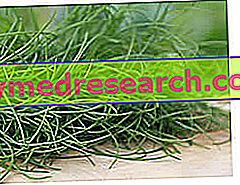Generality
Agretti - or monk's beard or Negus beard - are foods that belong to the group of vegetables and vegetables. They are suitable for consumption by means of cooking and constitute a product, widespread throughout the Italian peninsula, especially ideal for preparing side dishes.

Agretti have an annual life cycle and their availability on the market corresponds to the spring and early summer period. WARNING! Agretti or monk beards are suitable for food consumption almost exclusively in the form of young seedlings and shoots.
In the past, monk's beard also had different uses than food. Specifically, being rich in sodium, the agretti were dried, burned and processed to extract the soda (an alkaline compound necessary for various manufacturing processes).
Description, origins and cultivation
The monk beard is a small herbaceous plant (about half a meter tall). It forms small bushes fairly easy to identify and is filiform, fleshy, full and turgid to the touch.

The monk beard is native to Europe, Asia and northern Africa; it grows abundantly in the sea coasts and requires a particularly sandy and sodium-rich soil (also abundant in the plant itself). Thanks to its adaptability, it seems to take root optimally even in the American continent.
Agretti are foods that are widespread in the gastronomic culture of European countries overlooking the Mediterranean Sea; they represent an ordinary product especially in the diet of Italians and Spaniards.
Agretti can be harvested or cultivated; the search for the wild plant, as anticipated, must necessarily take place in the spring period (March-May), concentrating in the coastal territories. As far as agriculture is concerned, instead, cultivation is carried out on poor, draining and sandy soils, also rich in sodium (halophile plant); plants also require excellent sun exposure. Sowing must be abundant and, alternatively, small seedlings can be grounded in the autumn months.
NB . The monk's beard requires constant pruning to prevent it from growing and lignifying excessively.
Gastronomic uses
The monk's beard is particularly renowned for its sour, bitter and characteristic taste. Its leaves and stems are consumed, provided they are obtained from the buds of the adult plant or from small plants suitably deprived of the most coriaceous portions (in correspondence of the roots). It is necessary to wash it thoroughly, both in case of collection and in case of purchase; this depends on the fact that, growing in particularly draining soils, it often retains small sand residues.
The agretti's favorite consumption is by boiling (in tasteless water for about a quarter of an hour) or steaming; after cooling, they can be seasoned with lemon juice and extra virgin olive oil, or accompanied with tomatoes and anchovies (typical combination of southern Italy).
The monk's beard is rarely eaten raw; this requires the use of extremely young and tender raw materials. On the other hand, from cooked, as well as serving as a side dish, the agretti make up accompanying sauces for pasta dishes and fillings for savory appetizers; however, these destinations are decidedly marginal compared to the aforementioned.
Nutritional characteristics
Agretti are low energy foods, with a small portion of carbohydrates and an almost irrelevant fraction of proteins and lipids. The fibers are abundant and very useful to reach the recommended ration. The monk's beard performs excellently the function of satiating food, regulating the lipid absorption and moderating the glycemic index of the meal; for these characteristics, the agretti lend themselves considerably to the diet against overweight, type 2 diabetes mellitus and hyperlipemias.
On the other hand, as it is not in possession of the relative sodium and potassium content, it is not possible to state with certainty what their relevance could be in the diet against hypertension.
The monk's beard also contains good concentrations of calcium, vit. A and small amounts of vit. C and B group vitamins.
Nutritional values
Nutritional composition for 100g of raw Agretti; Agretti cooked, boiled without salt - Reference values of the INRAN Food Composition Tables.
 | |||||
| Raw Agretti | Cooked agnetti, boiled without salt | ||||
| Edible part | 97.0% | 100.0% | |||
| water | 92.3g | 79.4g | |||
| Protein | 1.8g | 4.8g | |||
| Prevailing amino acids | - | - | |||
| Limiting amino acid | - | - | |||
| Lipids TOT | 0.2g | 0.5g | |||
| Saturated fatty acids | -mg | -mg | |||
| Monounsaturated fatty acids | -mg | -mg | |||
| Polyunsaturated fatty acids | -mg | -mg | |||
| Cholesterol | 0.0mg | 0.0mg | |||
| TOT Carbohydrates | 2.2g | 5.6g | |||
| Starch | -g | -g | |||
| Soluble sugars | 2.2g | 5.6g | |||
| Dietary fiber | 2.2g | 2.3g | |||
| Soluble fiber | 0.38g | 0.41g | |||
| Insoluble fiber | 1.85g | 1.88g | |||
| Power | 17.0kcal | 45.0kcal | |||
| Sodium | -mg | -mg | |||
| Potassium | -mg | -mg | |||
| Iron | 1.2mg | -mg | |||
| Football | 131.0mg | -mg | |||
| Phosphorus | 34.0mg | -mg | |||
| Thiamine | 0.03mg | -mg | |||
| Riboflavin | 0.19mg | -mg | |||
| Niacin | 0.80mg | -mg | |||
| Vitamin A | 392.0μg | -μg | |||
| C vitamin | 24.0mg | -mg | |||
| Vitamin E | - mg | - mg | |||



